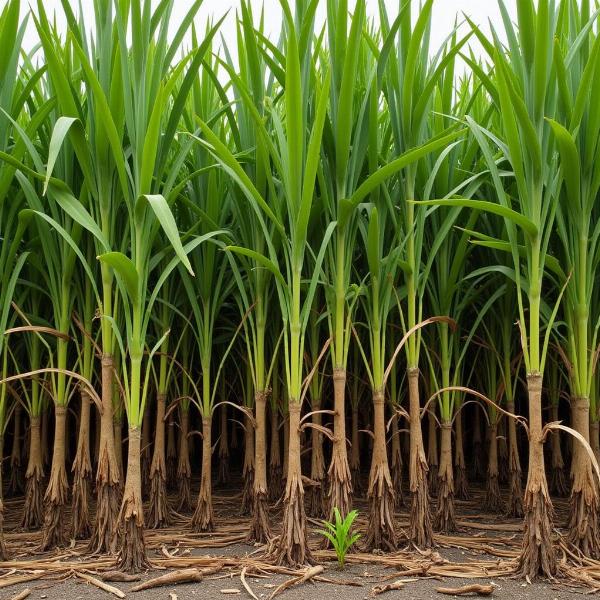Ratoon meaning in Hindi revolves around the concept of a new shoot or sprout, particularly from the stubble or base of a harvested crop like sugarcane or rice. Understanding the nuances of this word, its agricultural implications, and cultural significance is crucial for anyone seeking a deeper understanding of Indian agriculture and language.
What Does Ratoon Mean in Hindi?
The Hindi word for ratoon is generally “मूसल” (moosal) or “पैड़ी” (pairi). While both refer to the regrowth of a crop, “pairi” is more specific to sugarcane, while “moosal” can be used more broadly. These terms encapsulate the practice of allowing crops to regrow from their roots after harvesting, saving time and resources. Imagine a sugarcane field after harvest; instead of replanting, farmers let new shoots emerge from the cut stalks—these new shoots are the ratoon. This process forms a core part of sustainable agricultural practices in India.
 Ratoon sugarcane regrowth
Ratoon sugarcane regrowth
Ratoon Cropping: Benefits and Challenges
Ratoon cropping, particularly with sugarcane, offers significant advantages. It reduces the cost and labor involved in land preparation, planting, and irrigation. The ratoon crop typically matures faster than the original planting, leading to quicker yields. However, ratoon crops often produce less yield than the plant crop, and the yield generally decreases with each successive ratoon. Diseases and pests can also become a significant challenge.
The Cultural Significance of Ratoon
The concept of ratoon, representing regeneration and renewal, also finds subtle echoes in Indian culture and literature. It symbolizes resilience and the cyclical nature of life, death, and rebirth, themes often explored in Hindu philosophy. The practice itself also reflects a deep connection to the land and a respect for its ability to provide.
Ratoon in Different Indian Languages
While “pairi” is common in Hindi-speaking regions, other Indian languages have their own terms for ratoon. In Marathi, it’s known as “खोडवा” (khodava), while in Kannada, it’s “ಕೊಯ್ಲು” (koylu), highlighting the linguistic diversity of India.
Ratoon: A Sustainable Agricultural Practice
Ratoon cropping is a valuable agricultural practice, promoting sustainable farming by reducing the need for repeated planting and tillage. This helps conserve soil health and water resources, critical elements for food security in India.
What are the disadvantages of ratoon cropping?
Ratoon crops can be more susceptible to diseases and pests, and the yield typically decreases with each successive ratoon.
Is ratoon cropping common in India?
Yes, ratoon cropping, especially with sugarcane, is widely practiced in India due to its economic and environmental benefits.
Conclusion
Understanding the “ratoon meaning in Hindi” offers a glimpse into the complexities of Indian agriculture, language, and cultural practices. From the practical benefits of reduced costs and quicker yields to the symbolic representation of regeneration, ratoon holds a significant place in India’s agricultural landscape.
FAQ
- What is the most common ratoon crop in India? Sugarcane is the most common ratoon crop in India.
- How many times can a crop be ratooned? This depends on the crop and local conditions, but generally, sugarcane is ratooned two to three times, while rice might be ratooned once.
- What is the Hindi word for ratoon in sugarcane? “Pairi” (पैड़ी) is commonly used for sugarcane ratoon.
- Why is ratoon cropping considered sustainable? It reduces the need for land preparation, planting, and irrigation, conserving soil and water resources.
- What are the main challenges of ratoon cropping? Decreased yields in successive ratoons and increased susceptibility to pests and diseases are the main challenges.
- Is ratoon cropping only for sugarcane? No, other crops like rice and banana can also be ratooned, though sugarcane is the most common.
- What is the benefit of ratoon cropping for farmers? Ratoon cropping significantly reduces costs and labor, leading to faster and more efficient harvests.
Meaning-Hindi.in offers professional translation services for businesses and individuals needing accurate and culturally sensitive translations between Hindi and various other languages. Our expertise includes business and commercial document translation, certified and legal document translation, technical and user manual translation, website and localization, and academic translation services. We pride ourselves on delivering high-quality translations that capture the nuances of both source and target languages. For all your Hindi translation needs, contact us at [email protected] or call us at +91 11-4502-7584. Meaning-Hindi.in is your trusted partner for bridging language barriers and facilitating seamless communication.